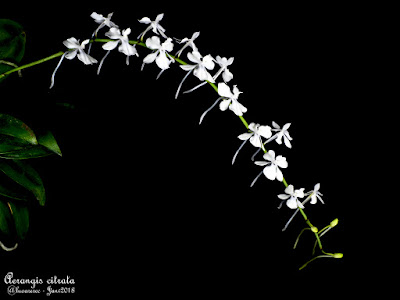Aerangis citrata is native to Madagascar. This popular, easily adaptive orchid grows in eastern Madagascar, starting from Fort-Dauphin in the south, through the central highlands to Sambava in the north. They are found from the sea level to the height of 1500 m, but they were also found at a height of 1900 m. They grow in the shade near the water.
Aerangis citrata orchid, also called as The Lemon-scented Aerangis, Aerobion citratum, Angorchis citrata, Angraecum citratum, Rhaphidorhynchus citratus, is a species of the genus Aerangis. This species was described by (Thou) Schlechter in 1914.
IDENTIFY AERANGIS CITRATA ORCHID
Aerangis citrata is native to Madagascar. This popular, easily adaptive orchid grows in eastern Madagascar, starting from Fort-Dauphin in the south, through the central highlands to Sambava in the north. They are found from the sea level to the height of 1500 m, but they were also found at a height of 1900 m. They grow in the shade near the water.
It is a miniature sized, cool to hot growing epiphytic with fine roots, a short stem. The leaves are 9-12 cm long and 2.5-3.5 cm wide. 3-4 pairs of spread, elliptical leaves are tight, double-row arranged on the shoot. They are unevenly distributed at the ends, have a light to dark green color and are very shiny, especially when they are young.
The Lemon-scented Aerangis blooms in the spring, summer and fall on a 16" long (40cm), pendant inflorescence with 12 to 30, fragrant, waxy, small flowers all held in the same plane. Flowers with a slightly lemon scent are not lemon-yellow in color as the name may suggest, but most of them appear to have a little yellow in the basic cream-white color. They are 1.5-1.7 cm in diameter and 1.7-2.0 cm in height.
AERANGIS CITRATA CARE AND CULTURE
Cultural information should only be used as a guide, and should be to be adapted to suit you. Your physical location; where you grow your plants, how much time you have to devote to their care, and many other factors, will need to be taken into account. Only then can you decide on the cultural methods that best suit you and your plants.
Light:
Aerangis citrata needs a light level of 12,000-18000 lux. This plant require shady positions and initiate flower shoots even grown at very low light levels. They should be protected from the direct sun. The ideal photoperiod is 12 hours. Strong air movement should be ensured all the time.
Temperature:
The Lemon-scented Aerangis is a thermophilic plant. In summer the average day temperature is 28-29 ° C, night 18 ° C, which gives a daily difference of 9-11 ° C. The average winter temperature is 22-23 ° C during the day and 11-12 ° C at night, giving a diurnal difference of 11-12 ° C.
Humidity:
This species needs a humidity level of 75-80% for most of the year. For 4 months of late winter and spring the humidity drops to about 65-70%.
Substrate, growing media and repotting:
Growing on rootstocks best suits the hanging inflorescences of this species. If Aerangis citrata is attached, it requires frequent spraying, otherwise it slowly dehydrates. Therefore, they are usually grown in small pots with excellent drainage or baskets, using a very permeable and fast-drying substrate such as a mix with fine fir bark.
Plants should be repotted when the substrate begins to decompose. Repotting is better done when new roots start to appear.
Watering:
Cultivated plants should be watered strongly during the period of active growth (in the period from late spring to autumn), but the roots must always dry quickly after watering.
Fertilizer:
Aerangis citrata should be fertilized every week 1/4-1/2 of the recommended dose of fertilizer for orchids. A fertilizer with a high nitrogen content is beneficial from spring to mid-summer, and a fertilizer richer in phosphorus should be used in late summer and autumn.
Rest period:
The Lemon-scented Aerangis require less water throughout the winter, but they should be watered regularly to prevent excessive drying. However, the amount of water supplied should be increased if the leaves wrinkle or show signs of weakness. Fertilization should be eliminated until new growths appear and more watering begins in the spring.















COMMENTS